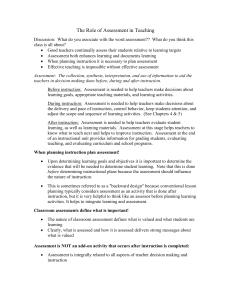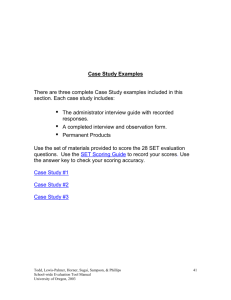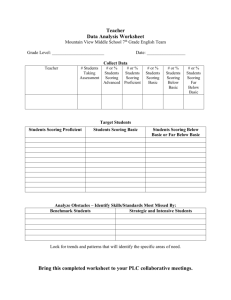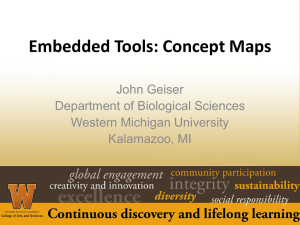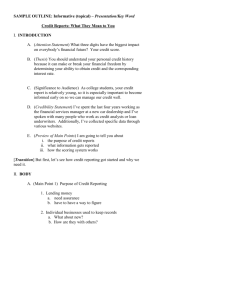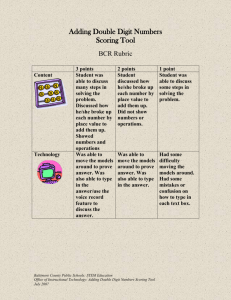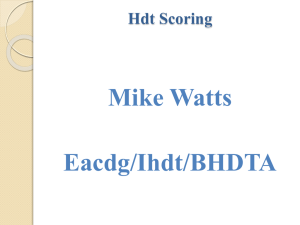INTRODUCTION TO C-TOOLS: CONCEPT MAPPING TOOLS FOR
advertisement
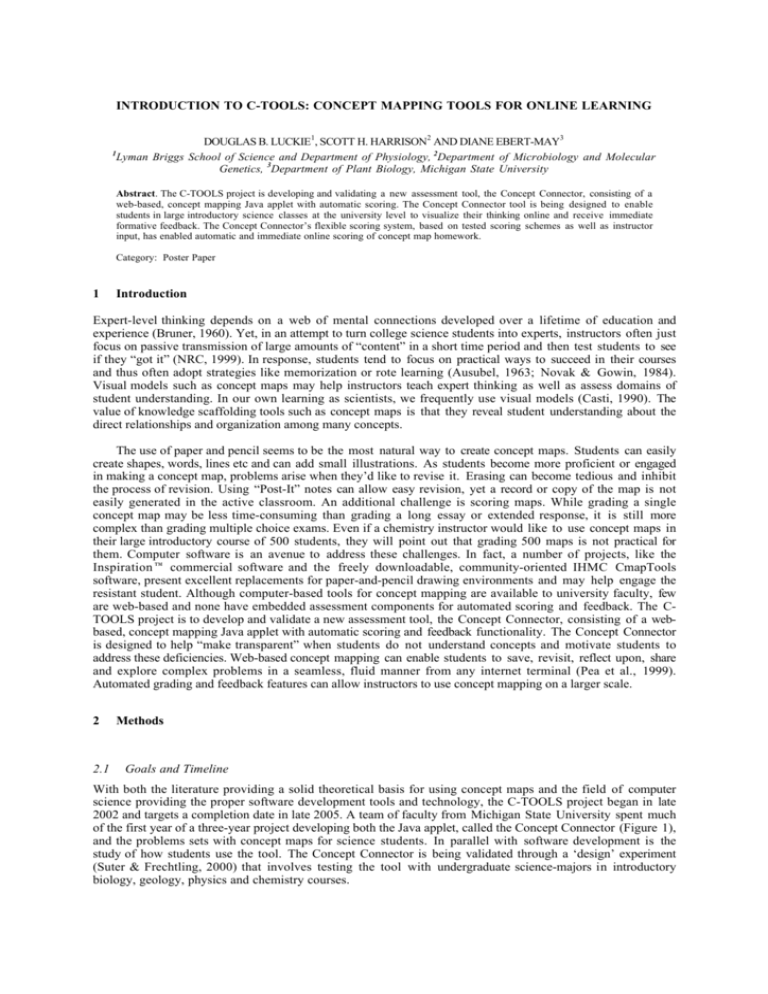
INTRODUCTION TO C-TOOLS: CONCEPT MAPPING TOOLS FOR ONLINE LEARNING DOUGLAS B. LUCKIE1, SCOTT H. HARRISON2 AND DIANE EBERT-MAY3 1 Lyman Briggs School of Science and Department of Physiology, 2Department of Microbiology and Molecular Genetics, 3Department of Plant Biology, Michigan State University Abstract. The C-TOOLS project is developing and validating a new assessment tool, the Concept Connector, consisting of a web-based, concept mapping Java applet with automatic scoring. The Concept Connector tool is being designed to enable students in large introductory science classes at the university level to visualize their thinking online and receive immediate formative feedback. The Concept Connector’s flexible scoring system, based on tested scoring schemes as well as instructor input, has enabled automatic and immediate online scoring of concept map homework. Category: Poster Paper 1 Introduction Expert-level thinking depends on a web of mental connections developed over a lifetime of education and experience (Bruner, 1960). Yet, in an attempt to turn college science students into experts, instructors often just focus on passive transmission of large amounts of “content” in a short time period and then test students to see if they “got it” (NRC, 1999). In response, students tend to focus on practical ways to succeed in their courses and thus often adopt strategies like memorization or rote learning (Ausubel, 1963; Novak & Gowin, 1984). Visual models such as concept maps may help instructors teach expert thinking as well as assess domains of student understanding. In our own learning as scientists, we frequently use visual models (Casti, 1990). The value of knowledge scaffolding tools such as concept maps is that they reveal student understanding about the direct relationships and organization among many concepts. The use of paper and pencil seems to be the most natural way to create concept maps. Students can easily create shapes, words, lines etc and can add small illustrations. As students become more proficient or engaged in making a concept map, problems arise when they’d like to revise it. Erasing can become tedious and inhibit the process of revision. Using “Post-It” notes can allow easy revision, yet a record or copy of the map is not easily generated in the active classroom. An additional challenge is scoring maps. While grading a single concept map may be less time-consuming than grading a long essay or extended response, it is still more complex than grading multiple choice exams. Even if a chemistry instructor would like to use concept maps in their large introductory course of 500 students, they will point out that grading 500 maps is not practical for them. Computer software is an avenue to address these challenges. In fact, a number of projects, like the Inspiration commercial software and the freely downloadable, community-oriented IHMC CmapTools software, present excellent replacements for paper-and-pencil drawing environments and may help engage the resistant student. Although computer-based tools for concept mapping are available to university faculty, few are web-based and none have embedded assessment components for automated scoring and feedback. The CTOOLS project is to develop and validate a new assessment tool, the Concept Connector, consisting of a webbased, concept mapping Java applet with automatic scoring and feedback functionality. The Concept Connector is designed to help “make transparent” when students do not understand concepts and motivate students to address these deficiencies. Web-based concept mapping can enable students to save, revisit, reflect upon, share and explore complex problems in a seamless, fluid manner from any internet terminal (Pea et al., 1999). Automated grading and feedback features can allow instructors to use concept mapping on a larger scale. 2 2.1 Methods Goals and Timeline With both the literature providing a solid theoretical basis for using concept maps and the field of computer science providing the proper software development tools and technology, the C-TOOLS project began in late 2002 and targets a completion date in late 2005. A team of faculty from Michigan State University spent much of the first year of a three-year project developing both the Java applet, called the Concept Connector (Figure 1), and the problems sets with concept maps for science students. In parallel with software development is the study of how students use the tool. The Concept Connector is being validated through a ‘design’ experiment (Suter & Frechtling, 2000) that involves testing the tool with undergraduate science-majors in introductory biology, geology, physics and chemistry courses. Figure 1: The Concept Connector Java applet graphic user interface (GUI). This particular screenshot shows the Java applet’s GUI (blue colored areas), how the software draws a concept map, and how new colors (green and yellow rectangular halos or red X’s) appear when the Robograder is asked to GRADE a concept map (http://ctools.msu.edu). 2.2 Faculty and Students: Concept Mapping in Large Introductory Courses For the C-TOOLS study, we are recruiting a cohort of over 1000 freshman and sophomore students enrolled in each of the six introductory science-major courses: Biology I & II, Chemistry I & II, and Physics I & II, as well as two non-major science courses: Introductory Biology and Geology. Students complete the concept maps as an integral part of the course (at a minimum two assigned homework problem sets at week 5 and 10 of the 15-week semester). Online concept map-based homework assignments may vary from analysis of scientific literature to answering a particular homework question. During class meetings in computer laboratories, students learn how to use the web tools. To complete an assignment students login to a website and are presented with instructions and a map space seeded with approximately 10 concepts. Students move the concept words around, organize hierarchy, and add linking words and lines. Students first construct a map individually, submit it to the computer and receive a score as well as visual feedback. They then can revise the map and resubmit. Finally, they work with a partner to complete a final collaborative concept map. Each new concept map submitted receives a new feedback and a new (frequently improved) score. 2.3 Faculty and Programmers: Software Development and Data Analysis The Concept Connector beta version has been created as the combination of an online Java applet that serves as a map drawing tool residing in an HTML page that communicates with server-side software on POSIXconforming systems such as Mac OS X, LINUX, and FreeBSD. The applet is 75 kilobytes in size and is browser-compatible on every OS platform and presents a menu-driven, interactive GUI. In terms of architecture, as a technology, a C-TOOLS server aspires to incorporate freely available software tools and follow existing software conventions within the freeware community. By implementing and interacting with necessary software components such as cross-linking databases, resource-specific handlers, and servlets in this manner, the CTOOLS project aims to explore and utilize open standards. This open architecture approach focuses the edge of development more directly on issues of concept map pedagogy as opposed to working within the limitations of first developing and delivering a customized and proprietary software toolset. The online software allows students to seamlessly create their concept map on an “easel” page, save it in a private “gallery,” restore, revise and submit it to receive automatic scoring feedback. In automated grading, our primary goal is to follow the scoring system developed by the Novak group (Novak & Gowin, 1984). In year 1, the automatic scoring feedback, named “Robograder”, gave only feedback concerning the validity of the semantic relationship between linked words in a proposition. Automated scoring of student linking words graded 26% of the user-made propositions existing on Michigan State University's C-TOOLS server. Automated scoring algorithms are continually being updated and embedded in the Concept Connector to allow for greater feedback to students. As expert faculty continue to score new propositions on a graduated scale, their input is added to a growing computer-based library that will ultimately have full capacity to score virtually all connections stored in our set of concept maps. In year 2, feedback concerning the arrangement of hierarchy and cross-links is being added to the software. Feedback to students is currently only visual (Figure 1) but as all the Novak assessment elements come online, automatic numeric grading feedback will also be enabled. In addition to the Novak scoring system, we are studying student maps for interesting trends and testing new “Gestalt” approaches for automated feedback that successfully mimic the human grader (Figure 2). We are studying more holistic domains such as frequency of word choice and links, network patterns and evaluative approaches based upon the structure of the map. Figure 2 presents an analysis of data from one C-TOOLS biology course. It aligns the distribution of grades (0-5) given by the expert faculty to student concept maps made during a semester (top panel) with an analysis of most common “hub” concept words found in the student maps (“hub”=concept with most links; middle panel) and “Gestalt” grading strategies where software attempts to evaluate the same student maps via content independent approaches (bottom panel). Figure 2. Human expert scoring of student maps from a non-majors biology course (top panel) and software analysis of trends in the map data (lower panels). Panel 1 (top) shows the distribution of scores (graded from 0 to 5) for each of 4 assignments given successively throughout a semester (n=76 students). The striped portions of the bars in panel 1 indicate the distribution of scores for maps that used the top “hub” concept word (for MAP1 this hub word was “photosynthesis,” identified in Panel 2 (middle)). Panel 3 shows trends in Gestalt scoring approaches applied to the same maps. These are the average values of 4 network topology measurements for the maps that scored a “5” (*) from each of the 4 assignments. Cycles=“C”, the number of loops involving 3 or more concept words; Degrees=“D”, the number of propositions connecting to a given concept word; Leaves=“L”, the number of terminal ends in the concept map network; RMS, an indicator of non-branching chains within a concept map=“R”, the root of the mean sum of squared distances between all concept word pairs within a concept map. C-TOOLS provides a well-curated data source with which to assess trends of classroom learning as shown in Figure 2. The instructor predicted the reduced student performance seen for MAP 3 based on complex interdependencies associated with the “Natural Selection” knowledge domain. The instructor also predicted that those students understanding certain critical concept words, as evidenced in MAP 1 by choosing words such as “photosynthesis” to be the most highly interconnected hub, would score the highest on their concept maps. The shift in grade distribution of maps (top panel, striped portions of bars) using the most popular “hub” word (identified in the middle panel) appears to support the prediction. Automated “Gestalt” grading approaches currently being tested are based on the network structure of the student concept maps. Methodologies using map network patterns related to hierarchy (“Leaves” and “Degrees”), cross-linking (“Cycles” and “RMS”), as well as the use of software called WordNet to amplify linking word databases are being studied (Harrison, Wallace, Ebert-May, & Luckie, 2004). In the bottom panel of Figure 2, four automated scoring strategies were tested on student concept maps that received a score of 5. Interestingly, topology measurements termed “RMS” and “Leaves” correlated best with the human grader. The capacity to analyze and verify these predictions will grow in power with the accumulation of additional data and classroom-to-classroom comparisons. 3 Summary The C-TOOLS project stems from the combined activities of an interdisciplinary team of faculty from Michigan State University. This National Science Foundation (NSF)-funded project strives to develop and validate a new assessment tool, the Concept Connector, consisting of a web-based, concept mapping Java applet with automatic scoring and feedback functionality. The Concept Connector tool is being designed to enable students in large introductory science classes to visualize their thinking online and receive immediate formative feedback. The validity of the Concept Connector is being determined by a “design” experiment (Suter & Frechtling, 2000) that involves testing the tool with undergraduate science-majors i n introductory biology, geology, physics and chemistry courses. Further details concerning the C-TOOLS project have been previously published (Luckie, Batzli, Harrison & Ebert-May, 2003). 4 Acknowledgements This research project is supported by grant DUE 0206924 from the National Science Foundation. We thank Drs. Janet Batzli, Susan Bagley, James Smith, Lynmarie Posey, Walter Benenson, Duncan Sibley, Tammy Long, Deborah Linton and Mr. Josh Wallace for their assistance in this project. References Ausubel, D. (1963). The Psychology of Meaningful Verbal Learning. Grune/Stratton. New York, NY. Bruner, J. (1960). The Process of Education. Harvard University Press. Cambridge, MA. Casti, J. L. (1990). Searching for certainty: what scientists can know. New York, W. Morrow, 496 p. Fisher, K. M. (2000). SemNet software as an assessment tool. In J.J. Mintzes, et al (eds.), Assessing science understanding: A human constructivist view. Academic Press. San Diego, CA. Harrison, S. H., Wallace, J. L., Ebert-May, D., & Luckie, D. B. (2004). C-TOOLS automated grading for online concept maps works well with a little help from “WordNet” Paper presented at CMC 2004 – 1st International Conference on Concept Mapping. Luckie, D. B., Batzli, J. M., Harrison, S., & Ebert-May, D. (2003). C-TOOLS: Concept-Connector Tools for Online Learning in Science. International Journal of Learning 10: 332-338. National Research Council. (1999). Transforming Undergraduate Education in Science, Mathematics, Engineering, and Technology. National Academy Press. Washington, DC Novak, J. D., & Gowin., D. D. (1984). Learning How to Learn. Cambridge Press. New York, NY. Pea, R., Tinker, R., Linn, M., Means, B., Bransford, J., Roschelle, J., His, S., Brophy, S., & Songer, N. (1999). Toward a learning technologies knowledge network. ETR&D. 47(2): 19-38. Suter, L., & Frechtling, J. (2000). Guiding principles for mathematics and science education research methods. NSF Report 00-113.

